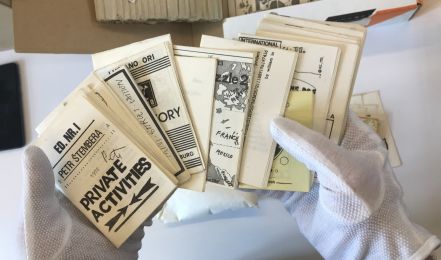‘70s’
- « previous
- 1
- 2
- 3
- 4
- next »
TÓTalJOY Prize
… name from Endre Tót’s conceptual program centred on the notion of joy, which was launched in the 1970s. His early joy pieces and the actions of the TÓTalJOY series are considered among the most important works of Eastern European conceptual art. The TÓTalJOY Prize, with a monetary value totalling EUR 10,000, aims to provide financial and institutional support to contemporary artists whose practice is research-oriented. Entries to the annually announced open call are expected from …
Artist Archives of the Future
… a prominent artist and theorist of the Polish neo-avantgarde, represents the art network of the 1970s and 1980s. Similar to—and in part overlapping with—Artpool, it has a significant collection of mail art, including works by several Hungarian artists (e.g. Sándor Pinczehelyi, László Beke, Gábor Attalai, György Galántai, Gábor Tóth and Dóra Maurer). The outcome of this collaboration was on view for the general public in November 2024, at the Platán Gallery in Budapest. Exhibiton …
Networking the Peripheries / World Art Post: International Artist Stamp Exhibition
… Studio (1970–1973), has been continuously expanding his international mailing list since the 1970s, through which he initially sent his own publications. In 1973, the exhibition Text(s) (organized by Dóra Maurer and Gábor Tóth) featured works by Uruguayan artist Clemente Padín (1939), as well as works by Western and Eastern European artists. Galántai institutionalized his growing archive of art documents he received from all over the world largely through the mail art network when he …
Dóra Halasi
… University, Piliscsaba. Her thesis examined the connection between dance and visual art in the 70s, which has been marginalized in the history of art. Since 2005 she has been an archivist and art historian at the Artpool Art Research Center, specialising in audio and video archives, the poster collection, and the associated research service. Since 2007 she has been Artpool’s chief photo and video documenter, and has been responsible for archiving media (video and audio digitalization). …
Flóra Barkóczi
… the post-1960s avant garde art in Hungary, primarily including conceptual photography of the 1960-70s, media art of the 1980-90s, Internet-based art and Internet culture of the 1990s and contemporary photo-based art practices. List of publications Publications
- « previous
- 1
- 2
- 3
- 4
- next »




